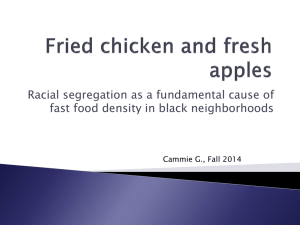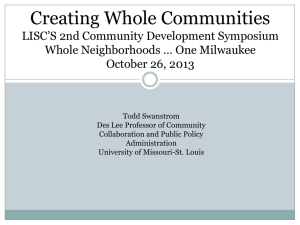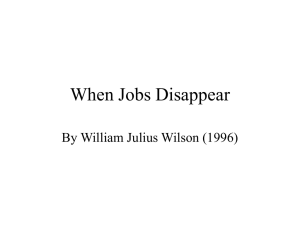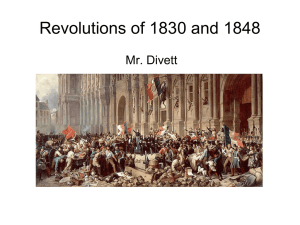PPTX - National Neighborhood Indicators Partnership
advertisement
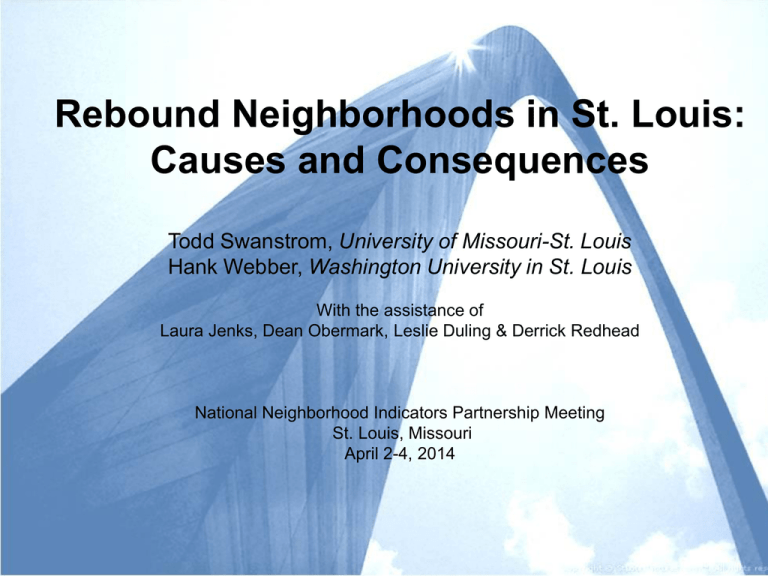
Rebound Neighborhoods in St. Louis: Causes and Consequences Todd Swanstrom, University of Missouri-St. Louis Hank Webber, Washington University in St. Louis With the assistance of Laura Jenks, Dean Obermark, Leslie Duling & Derrick Redhead National Neighborhood Indicators Partnership Meeting St. Louis, Missouri April 2-4, 2014 Research Focus: Dynamics of Neighborhood Change Two primary questions: 1. Why do some neighborhoods rebound in the wake of urban decline while others continue to decline or stagnate? 2. Do rebound neighborhoods in St. Louis fit the pattern of gentrification or do they vary in significant ways both in the path to revitalization and the impact on previous residents of the neighborhood and surrounding areas? Plan for Today 1. Quantitative analysis identifying rebound neighborhoods and some of their effects (Todd) 2. Case studies of the drivers of neighborhood revitalization with a focus on one neighborhood, the Central West End (Hank) St. Louis: A Slow-Growth Region 50% 45% 40% St. Louis MSA 35% Los Angeles MSA 30% Chicago MSA 25% Miami MSA 20% Boston MSA 15% San Francisco MSA 10% 5% 0% 1970-1980 -5% 1980-1990 1990-2000 2000-2010 St. Louis: A Thinning Out Region Decentralized Job Clusters Overbuilt Housing Ratio of New Housing Units to New Households for St. Louis MSA 1.60 1.437 1.40 1.20 1.274 1.080 0.991 1.00 0.80 0.60 0.40 0.20 0.00 1970-1980 1980-1990 1990-2000 2000-2011 Study Area • 218 census tracts in “urbanized area” of St. Louis as defined by the U.S. Census Bureau in 1950 • Total population of study area in 1970: 1.3 million Regional Sprawl Population Decentralization Change in Population of MSA and Study Area by Decade 140.00% 120.00% 118.17% Percentage of 1970 Popula on 110.18% 100.00% 100.00% 80.00% 99.72% 103.43% 79.59% 71.38% MSA 64.88% 60.83% 60.00% 40.00% 20.00% 0.00% 1970 1980 1990 2000 2010 Source(s): U.S. Decennial Census 1970-2000; American Community Survey 2006-2010 Study Area Falling Occupancy Rates, Especially in Older Areas Percentage of Occupied Housing Units in St. Louis, MO-IL MSA and Study Area by Decade 96.00% 94.00% 93.90% 93.23% 93.60% 92.60% 92.00% 91.93% 91.90% 90.2% 90.00% 89.12% 88.71% 88.00% MSA Study Area 86.00% 84.97% 84.00% 82.00% 80.00% 1970 1980 1990 2000 2010 Source(s): U.S. Decennial Census 1970-2000; American Community Survey 2006-2010 Older Neighborhoods – Running Up the Down Escalator Neighborhood Vitality Index (NVI) Three variables: 1. Economic (Per Capita Income) 2. Social (Poverty Rate) 3. Physical (Vacancy Rate) NVI measures the performance of each census tract relative to the mean for the study area in each decade. Neighborhood Vitality Index Tract Rankings by Decade, 1970-2010 Identifying Rebound Neighborhoods • Basic idea: neighborhoods that bounced back from decline (U-shaped) • We define a “rebound tract” as any census tract that moved up at least 10 percentile points in the rankings from 1990-2000 or 2000-2010 • Eliminated tracts that were never in the bottom half of the distribution at some point between 1970 and 2000 • Of the 218 tracts in our study area, 38 (17%) are rebound tracts Rebound Census Tracts Fit the Demographic Profile of Gentrifying Neighborhoods Surprising Finding In contrast to conventional wisdom on gentrifying neighborhoods, rebounding tracts, overall, had significantly higher levels of racial/ethnic and economic diversity than non-rebounding tracts. Racial/Ethnic Diversity Diversity Index = 1 - %white2 + %black2 + %Hispanic2 + %other2 Economic Diversity What Are the Drivers of Rebound Neighborhoods? 1. Economic Theory 2. Sociological Theory 3. Political/Institutional Theory Five Case Studies: Exploring the Drivers of Success Performance of Case Study Neighborhoods 250 200 Central West End Index Score Botanical Heights 150 Shaw Maplewood 100 Mark Twain Study Area Mean 50 0 1970 1980 1990 2000 2010 Racial Diversity of Case Study Neighborhoods 100 80 % non-white Central West End Botanical Heights 60 Shaw Maplewood 40 Mark Twain Study Area Mean 20 0 1970 1990 2010 Case Studies: Key Success Factors Central West End Botanical Heights Shaw Mark Twain Strong Anchor Institutions X X X X Excellent Housing Stock X Thoughtful Commercial Development X Thoughtful Residential Development X X Resident Civic Engagement X X X Good Location X X X Successful Public Policy X Success Factor Strong Public Schools Maplewood X X X X X X X Central West End – Location St. Louis City, County, and Region Central West End – Location Central West End – Borders Central West End – Housing Central West End – Housing Central West End – Housing Central West End – Apartments Central West End – Chase Park Plaza Central West End – Euclid Avenue Central West End – Euclid Avenue Central West End – Weak Housing Central West End – 1970-2010 1970 1990 2010 25,859 17,282 15,589 24% 22% 24% $23,078 $38,690 $43,406 Occupancy 85% 86% 86% % Under 18 20% 10% 7% % 18-34 28% 35% 44% % White 54% 59% 58% 100.84 164.15 192.12 Population Poverty Rate Per Capita Income* Index Score *in 2012 dollars Central West End – The 1970s • Assets – Excellent housing stock – Great location • Threats – Housing and commercial areas in state of disrepair – Weakening public schools – Exodus of families Key Success Factor – Growth in Anchor Institutions Washington University Medical Campus, 1970 2.0 million square feet Key Success Factor – Growth in Anchor Institutions Washington University Medical Campus, 2008 5.6 million square feet Central West End – Case Study: 4388 Waterman Central West End – Success Factors • Strong anchor institutions in growing industries • Excellent housing stock • Supportive public policy • Resident civic engagement • Thoughtful and contextual commercial and residential development Central West End – What Did Not Happen • No great transformative change in low-income and minority population • No significant change in building stock • Limited spill-over effects north of Delmar Central West End – Fountain Park Central West End – Fountain Park Central West End – Fountain Park Conclusions • Neighborhoods with strong anchor institutions and high levels of civic capacity are better able to utilize the public policy tools for revitalization (tax credits, special taxing districts, overlay zoning districts, etc.) • Location, Location, Location – Proximity to growing job centers is key – In the central corridor or well-located suburbs considerable success is possible – It is very difficult for all-black neighborhoods to rebound; in North St. Louis, stability is a victory • Diversity is now an asset to community revitalization Remaining Questions • Is St. Louis an outlier, or can neighborhoods in other weak market cities rebound without significantly displacing low-income and minority residents? • Are rebound neighborhoods in St. Louis simply the first stage on route to classic gentrification as found in strong market cities? • Are diverse rebound neighborhoods the result of a significant attitudinal change, especially by Millennials? If so, will this preference for diversity endure as Millennials age or will they revert back to attitudes of earlier generations? We would like to thank the many people and organizations that shared their experiences and history with us. We commend the hard work and dedication of those who have contributed to the revitalization of neighborhoods in St. Louis and elsewhere. Questions?
